
The Bottom Line
Introduction, Specifications, Pricing & Availability
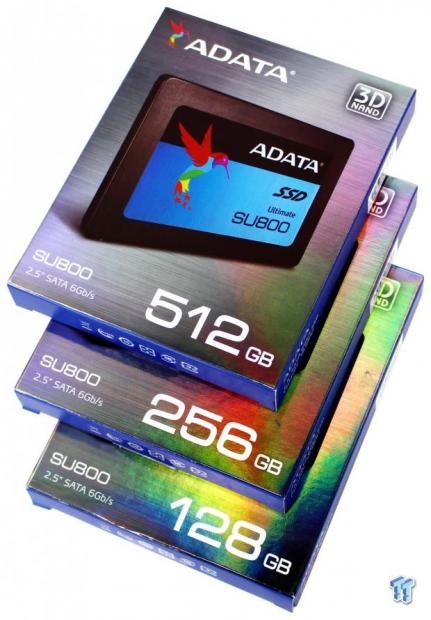
ADATA's Ultimate SU800 (or SU800 as we will refer to it going forward) is the first SSD we've reviewed that is powered by SMI's recently launched SM2258 4-channel controller. We haven't been happy with SMI-controlled SSDs since back in the SM2246 days when everything was still MLC-based. We've tested a ton of SMI SM2256-powered SDDs, and none have earned a TweakTown recommendation, simply because none could sustain write transfers of more than about 125 MB/s, which is slower than a typical mechanical HDD.
We recently reviewed the SMI SM2260-powered Intel 600p NVMe SSD, and it had the same issue even though it is a Gen3 x4 PCIe NVMe SSD with 3D flash. We will go ahead and tell you up front that the SM2258-powered SU800 does not have this issue. Even the 128GB model delivers over 350 MB/s with our write transfer test.
ADATA's SU800 has a Micron 3D TLC flash array under the hood. This is the same 384Gbit 3D TLC flash that powers Crucial's MX300 and Intel's 600p. The SU800 will be competing directly with Crucial's popular MX300 for market share. They both have the same flash array but employ different controllers. Crucial's MX300 is powered by Marvell's 88SS1074 4-channel flash controller, the SU800, as mentioned, is powered by SMI's SM2258 4-channel controller. The SM2258 is armed with an advanced LDPC (Low-Density Parity Check) ECC engine. LDPC error correction significantly extends the endurance of SU800's flash array netting the SU800 more than double the endurance of the MX300 at similar capacity points.
As with all modern TLC SSDs, the SU800 employs pSLC caching to boost burst performance. SMI calls the SLC caching scheme used by the SM2258 "Intelligent SLC Caching." We don't know a whole lot about the technical details of SMI's Intelligent SLC Caching technology, other than it seems to be dynamic in nature and that it functions far better than what we've seen previously from SMI-controlled SSDs. Unlike what we see from the MX300 series, the extra capacity that is inherent to Micron 384Gbit flash isn't rolled into extra user capacity or OP, but rather into the SU800's SLC cache capacity, which should be very good from a performance standpoint. Let's take a close look at that performance.
Specifications
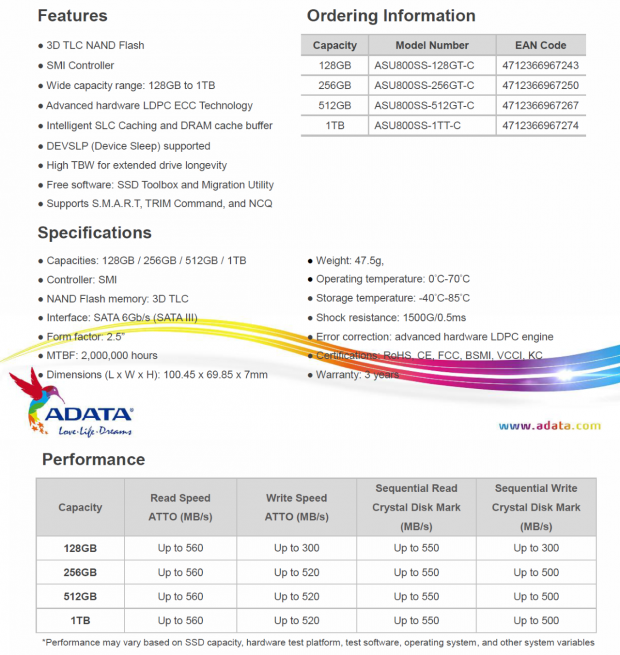
ADATA Ultimate SU800 SATA III SSD:
- Sequential Read: up to 560 MB/s
- Sequential Write: up to 520 MB/s
- Max 4K Random Read Speed: up to 80,000 IOPS
- Max 4K Random Write Speed: up to 80,000 IOPS
- Endurance: up to 800TBW
- MTTF: 2 Million Hours
- Warranty: 3-Year Limited Warranty
- DEVSLP
- ECC: LDPC
- SMART
- TRIM
- Garbage Collection
- Software: SSD Toolbox, Migration Software
Current Pricing: 128GB = $49.99, 256GB = $69.99, 512GB = $129.99, 1TB = Unknown
Drive Details
ADATA Ultimate SU800 SATA III SSD
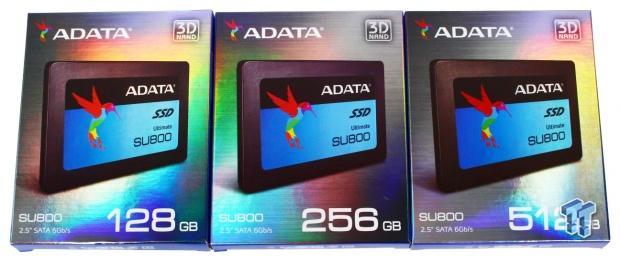
The front of the packaging has a reflective surface that reflects light in all colors of the rainbow.

The rear of the packaging lists "up to" sequential performance and features.

A plastic spacer and printed guide are included with the SSD.
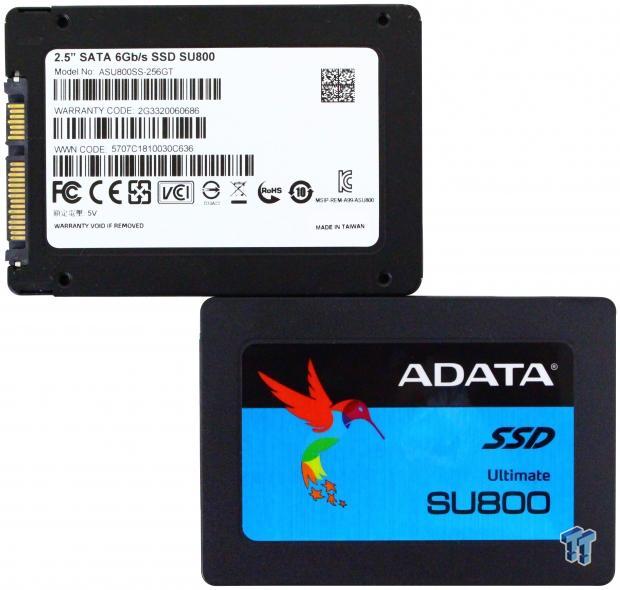
The top of the enclosure is plastic and features a colorful manufacturer label. The bottom and sides of the enclosure is formed from sheet aluminum.

The three capacity points we are testing employ the same half-length PCB. The drive's controller, DRAM cache package, and 1/3 of its Micron 3D TLC flash packages populate this side of the PCB.
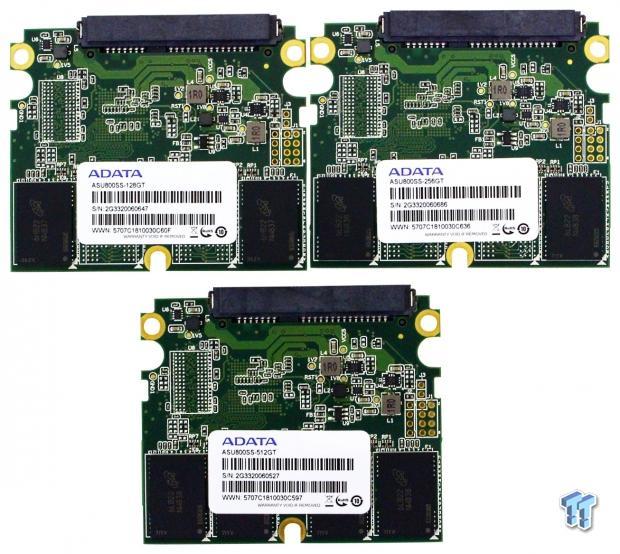
The remaining Micron 3D TLC flash packages populate this side of the PCB.
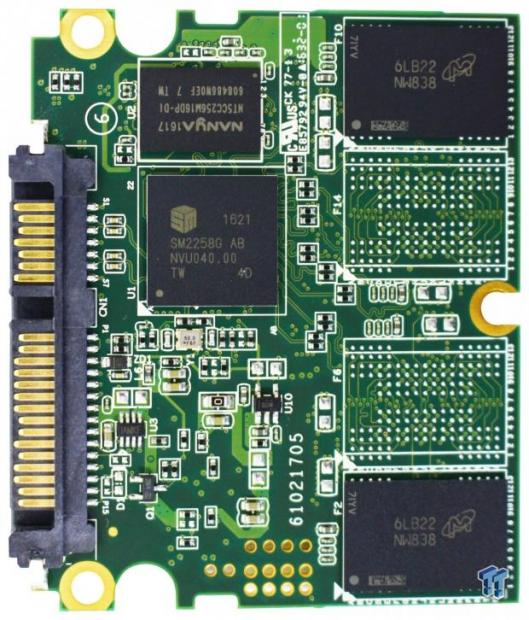
A close-in view of the drive's SMI SM2258G 4-channel controller, DRAM cache package, and flash packages.
Test System Setup and Properties
Jon's Consumer SSD Review Test System Specifications
- Motherboard: ASRock Extreme9 Z97 - Buy from Amazon
- CPU: Intel Core i7 4790K @ 4.8GHz - Buy from Amazon / Read our review
- Cooler: Swiftech H2O-320 Edge - Buy from Amazon / Read our review
- Memory: Corsair Dominator DDR3 32GB 2400MHz - Buy from Amazon
- Video Card: Onboard Video
- Case: IN WIN X-Frame - Buy from Amazon / Read our review
- Power Supply: Seasonic Platinum 1000 Watt Modular - Buy from Amazon / Read our review
- OS: Microsoft Windows 10 Professional 64-bit - Buy from Amazon
- Drivers: Intel RAID option ROM version 13.0.0.2075 and Intel RST driver version 14.8.0.1042
We would like to thank ASRock, Crucial, Intel, Corsair, RamCity, IN WIN, and Seasonic for making our test system possible.
Drive Properties
ADATA SU800 128GB OS Disk 75% Full
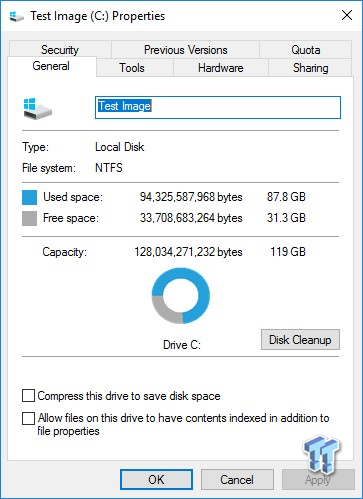
ADATA SU800 256GB OS Disk 75% Full
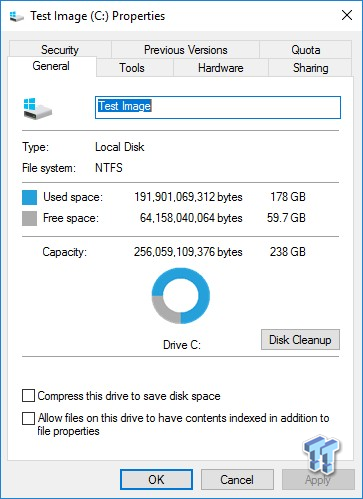
ADATA SU800 512GB OS Disk 75% Full

The majority of our testing is performed with our test drive as our boot volume. Our boot volume is 75% full for all OS Disk "C" drive testing to replicate a typical consumer OS volume implementation. We feel that most of you will be utilizing your SSDs for your boot volume and that presenting you with results from an OS volume is more relevant than presenting you with empty secondary volume results.
System settings: Cstates and Speed stepping are both disabled in our systems BIOS. Windows High-Performance power plan is enabled. Windows write caching is enabled, and Windows buffer flushing is disabled. We are utilizing Windows 10 Pro 64-bit OS for all of our testing except for our MOP (Maxed-Out Performance) benchmarks where we switch to Windows Server 2008 R2 64-bit. Empty Windows 10 benchmark screenshots will also be shown on our MOP page.
We will be charting all three capacity points and presenting benchmark screenshots for the 512GB model.
Synthetic Benchmarks – ATTO & Anvil's
ATTO
Version and / or Patch Used: 2.47
ATTO is a timeless benchmark used to provide manufacturers with data used for marketing storage products. With ATTO, we are looking at maximum sequential performance with compressible data as well as the performance curve.

Sequential Write
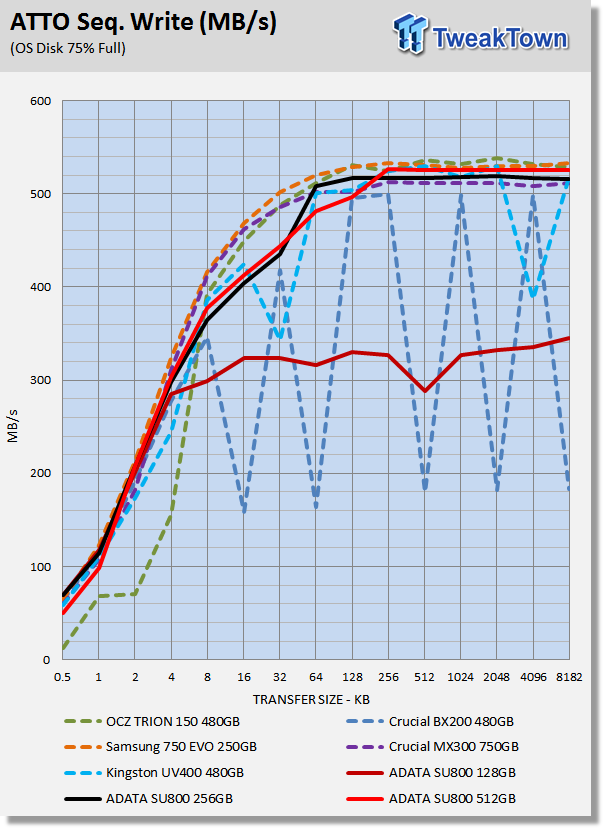
All three capacities we are testing deliver sequential write performance that is at or above factory spec. All three deliver a nice performance curve at low queue depths. We included the Crucial BX200 as a comparison between the SMI SM2256 and SM2258 controllers. It is obvious right off the bat that the SM2258-controlled SU800's doesn't suffer the same choppy performance curve that plagues the SM2256 controlled BX200.
Sequential Read
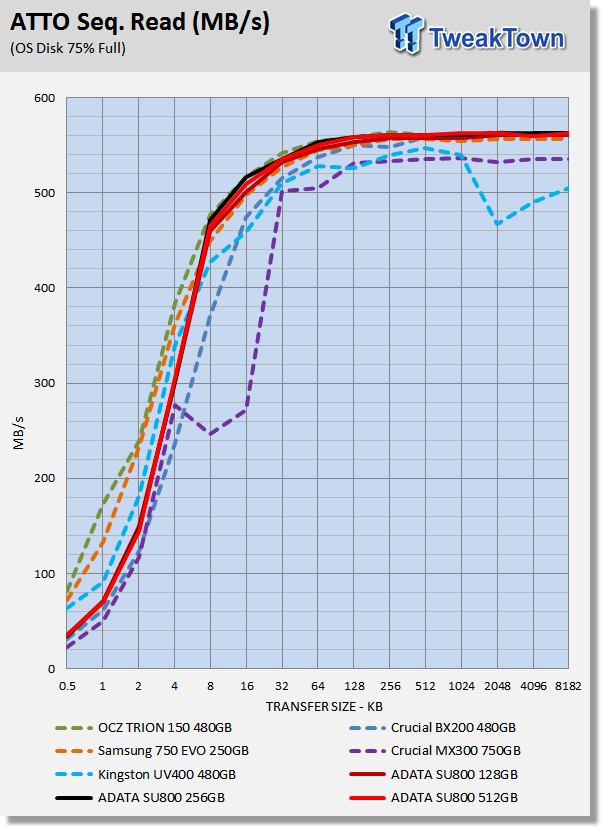
The SU800's all deliver a similar performance curve to one another. The SU800's hit their stride at QD8, at lower queue depths, the SU800's are outperformed by the planar-based SSDs in our test pool. Low QD random read performance is where we would like to see better performance from Micron 3D flash. Crucial's MX300 sports the same flash array as the SU800. The SU800's display better sequential read performance than the MX300 which bodes well for SMI's SM2258 controller.
Anvil Storage Utilities
Version and / or Patch Used: 1.1.0
Anvil's Storage Utilities is a storage benchmark designed to measure the storage performance of SSDs. The Standard Storage Benchmark performs a series of tests; you can run a full test or just the read or write test, or you can run a single test, i.e. 4k QD16. With Anvil's, we are focused on the total score.

Scoring
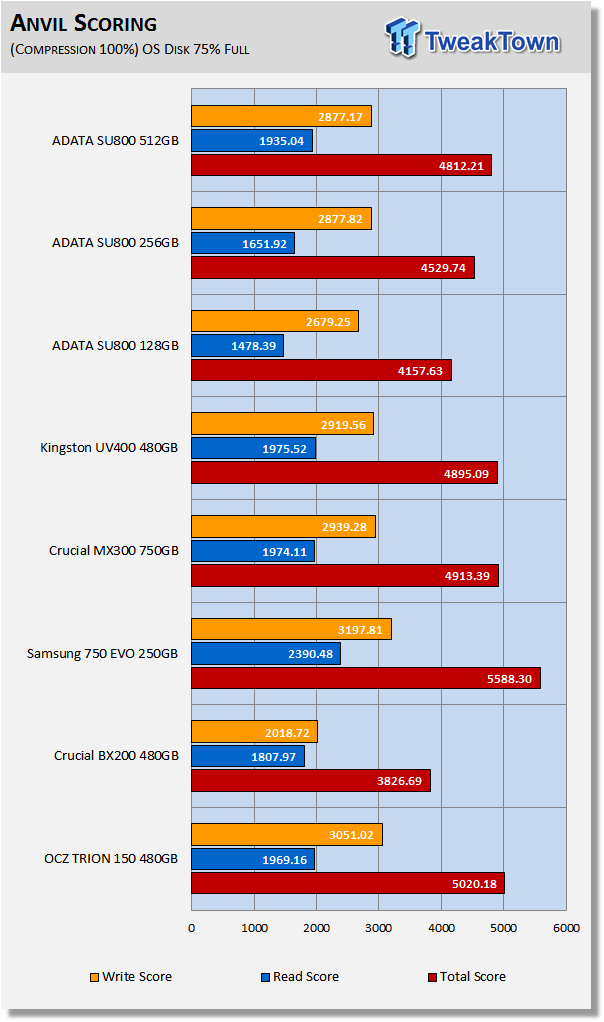
Anvil's scoring typically provides us with a good indication of a drive's overall synthetic performance. When evaluating TLC-based SSDs we are looking for a minimum score of 4,500. The 256GB and 512GB models give us what we are looking for, the 128GB model doesn't get there.
(Anvil) Read IOPS through Queue Depth Scale

Unlike sequential read performance, random read performance exposes a significant difference between capacity points at high queue depths. At QD1-2, the SU800 has the advantage over Crucial's MX300. At QD8 and above, the MX300 delivers better random read performance. Samsung's 750 EVO easily outperforms the rest of the drives in our test pool at all measured queue depths.
(Anvil) Write IOPS through Queue Scale
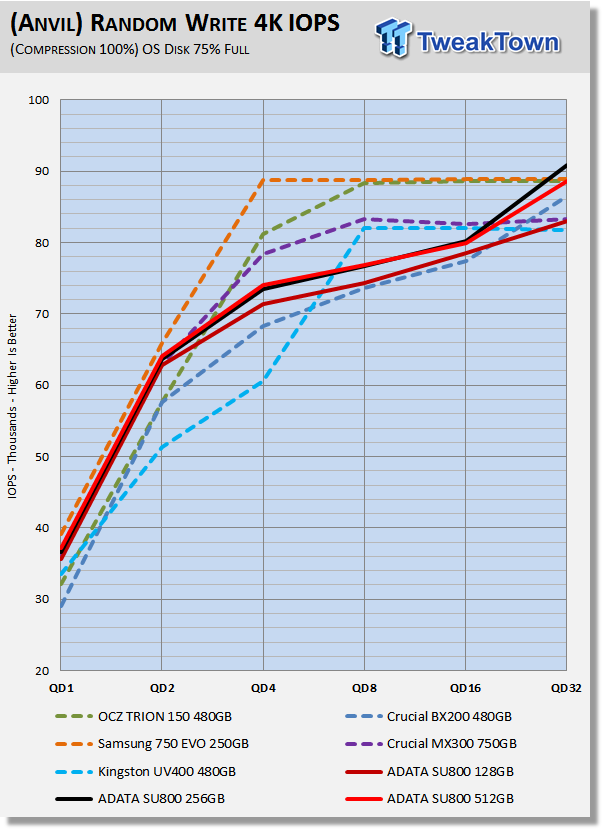
Low queue depth performance is what we are looking for, and this is where we find the SU800 delivering excellent performance at all three capacity points. Due to the SU800's high capacity SLC cache, there isn't much difference between capacity points.
Synthetic Benchmarks - CDM & AS SSD
CrystalDiskMark
Version and / or Patch Used: 3.0 Technical Preview
CrystalDiskMark is disk benchmark software that allows us to benchmark 4K and 4K queue depths with accuracy. Note: Crystal Disk Mark 3.0 Technical Preview was used for these tests since it offers the ability to measure native command queuing at QD4. With this version of CDM, we are focused on 4K random performance at QD1 and QD4.
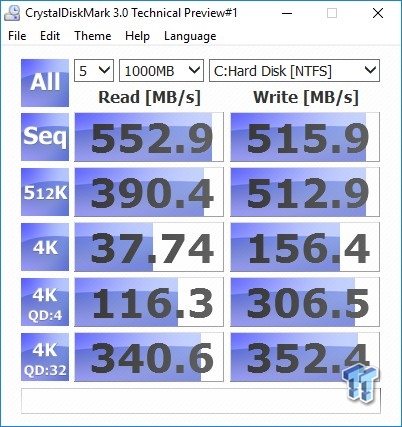
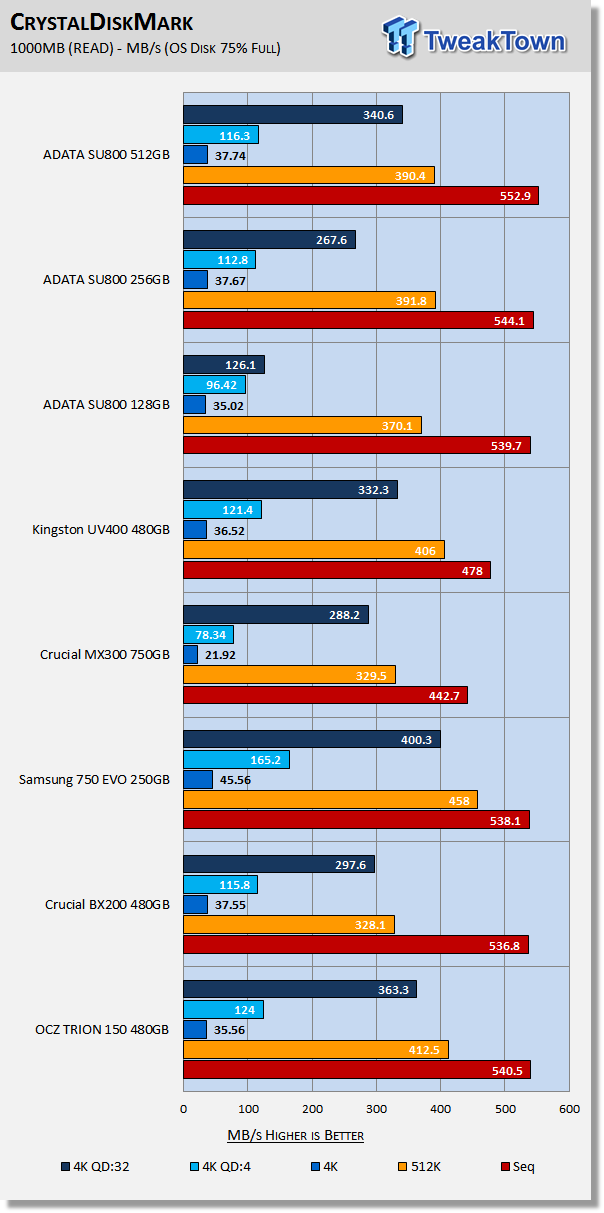
The SU800 delivers superior sequential performance, but that's not what we focus on with CDM. When we turn our attention to random performance at QD1, the SU800 does quite well except when compared with Samsung's 750 EVO. When we directly compare the SU800 to Crucial's MX300, we see that the SU800 has a distinct advantage at low queue depths.

The SU800 delivers the goods where it matters most; QD1. It also displays exceptional random write performance at QD4 which is what we are looking for from a good OS disk. When we directly compare the SU800 to Crucial's MX300, we see that the SU800's SLC caching delivers better overall burst write performance.
AS SSD
Version and / or Patch Used: 1.8.5611.39791
AS SSD determines the performance of SSDs. The tool contains four synthetic as well as three practice tests. The synthetic tests are to determine the sequential and random read and write performance of the SSD. We focus on total score when evaluating AS SSD.
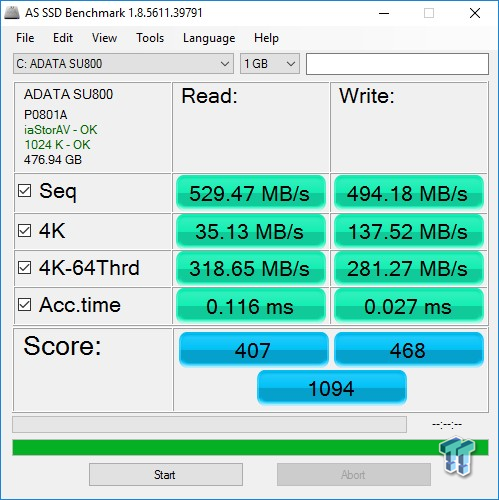
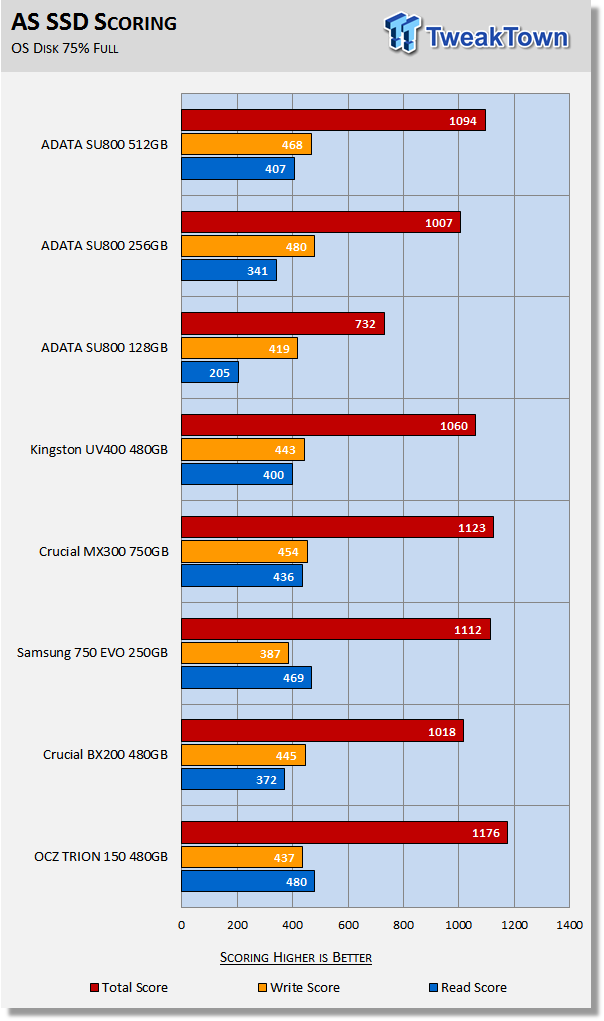
AS SSD is a demanding test. With AS SSD we are looking for a minimum score of 1000 from a TLC SSD. The SU800 gives us what we are looking for at the 256GB and 512GB capacity points. The 128GB model takes a big hit on the read portion of the test where the drive's SLC cache has little to no effect on performance, causing it to deliver an inferior score.
Benchmarks (Trace, OS Volume) - Vantage, PCMark 7 & PCMark 8
Moderate Workload Model
We categorize these tests as indicative of a moderate workload environment.
PCMark Vantage - Hard Disk Tests
Version and / or Patch Used: 1.2.0.0
The reason we like PCMark Vantage is because the recorded traces are played back without system stops. What we see is the raw performance of the drive. This allows us to see a marked difference between scoring that other trace-based benchmarks do not exhibit. An example of a marked difference in scoring on the same drive would be empty vs. filled vs. steady state.
We run Vantage three ways. The first run is with the OS drive 75% full to simulate a lightly used OS volume filled with data to an amount we feel is common for most users. The second run is with the OS volume written into a "Steady State" utilizing SNIA's guidelines. Steady state testing simulates a drive's performance similar to that of a drive that been subjected to consumer workloads for extensive amounts of time. The third run is a Vantage HDD test with the test drive attached as an empty, lightly used secondary device.
OS Volume 75% Full - Lightly Used

OS Volume 75% Full - Steady State

Secondary Volume Empty - FOB

There's a big difference between an empty drive, one that's 75% full/used, and one that's in a steady state.
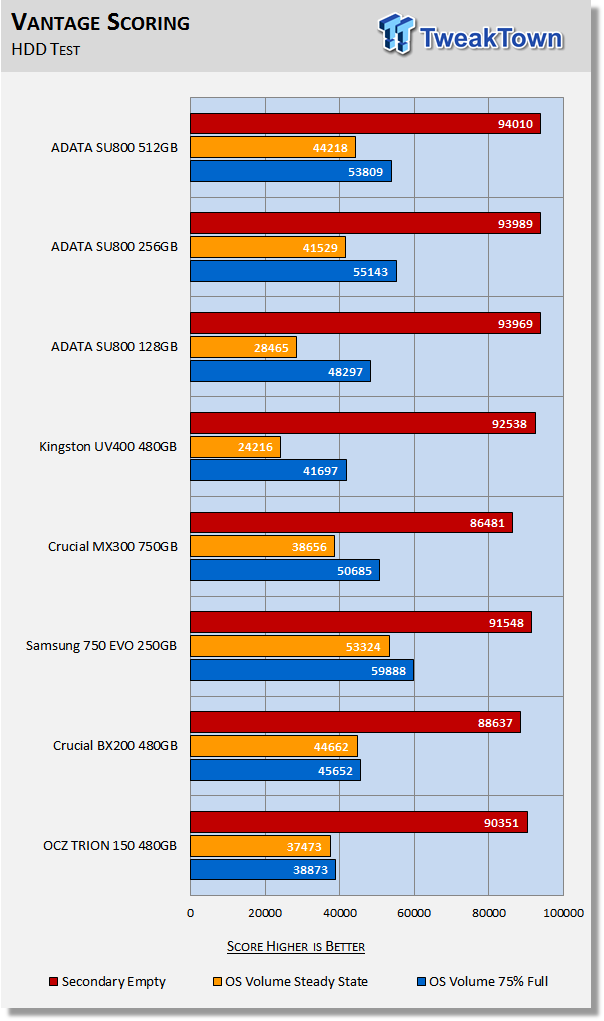
The important scores to pay attention to are "OS Volume Steady State" and "OS Volume 75% full." These two categories are most important because they are indicative of typical of consumer user states. When a drive is in a steady state, it means garbage collection is running at the same time it's reading/writing.
When tested as empty secondary volumes the SU800's outscore the competing SSDs in our test pool at all three capacity points. However, that is not what we are interested in. When testing TLC-based SSDs, we like to focus primarily on the drive's 75% full performance because we feel that those purchasing low-cost TLC SSDs will be running light to moderate bursty workloads that will not induce a steady state.
At 75% full, the 256GB and 512GB models deliver performance that is second to that of Samsung's powerful 750 EVO. The two larger capacity models outperform the MX300 due to their superior low queue depth random performance, which has a big influence on Vantage scoring when data is on the drive.
PCMark 7 - System Storage
Version and / or Patch Used: 1.4.0
We will look to Raw System Storage scoring for evaluation because it's done without system stops and, therefore, allows us to see significant scoring differences between drives.
OS Volume 75% Full - Lightly Used

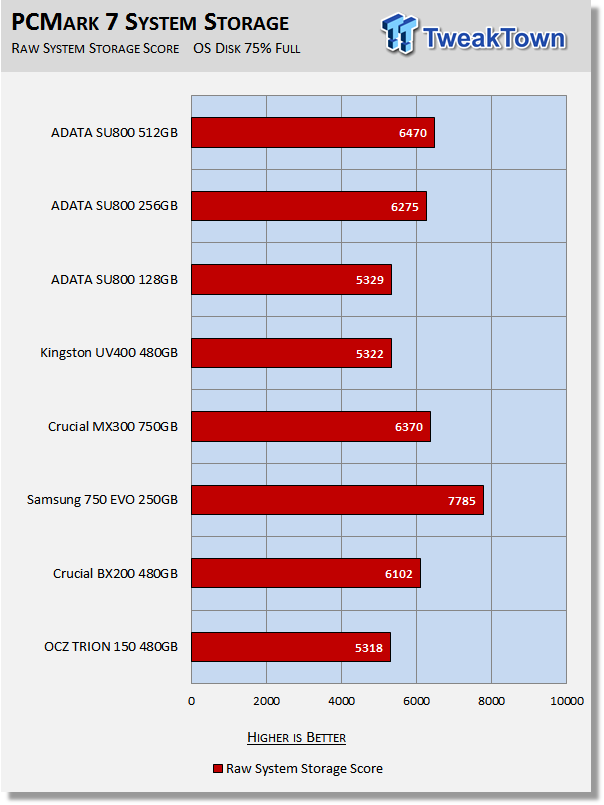
The 256GB and 512GB models both deliver above average moderate workload performance. The 128GB model is significantly slower. However, it does perform equally to the TRION 150 which is a drive that is TweakTown recommended.
PCMark 8 - Storage Bandwidth
Version and / or Patch Used: 2.4.304
We use PCMark 8 Storage benchmark to test the performance of SSDs, HDDs, and hybrid drives with traces recorded from Adobe Creative Suite, Microsoft Office, and a selection of popular games. You can test the system drive or any other recognized storage device, including local external drives. Unlike synthetic storage tests, the PCMark 8 Storage benchmark highlights real-world performance differences between storage devices. We focus on the total storage bandwidth when evaluating PCMark 8 results.
OS Volume 75% Full - Lightly Used


PCMark 8 is the most intensive moderate workload simulation we run. With respect to moderate workloads, this test is what we consider to be the best indicator of a drive's overall performance. This time the MX300 gets the better of the 512GB SU800.
Benchmarks (Secondary) – IOPS, Response & Transfers
Iometer – Maximum IOPS
Version and / or Patch Used: Iometer 2014
We use Iometer to measure high queue depth performance. (No Partition)
Max IOPS Read

Max IOPS Write

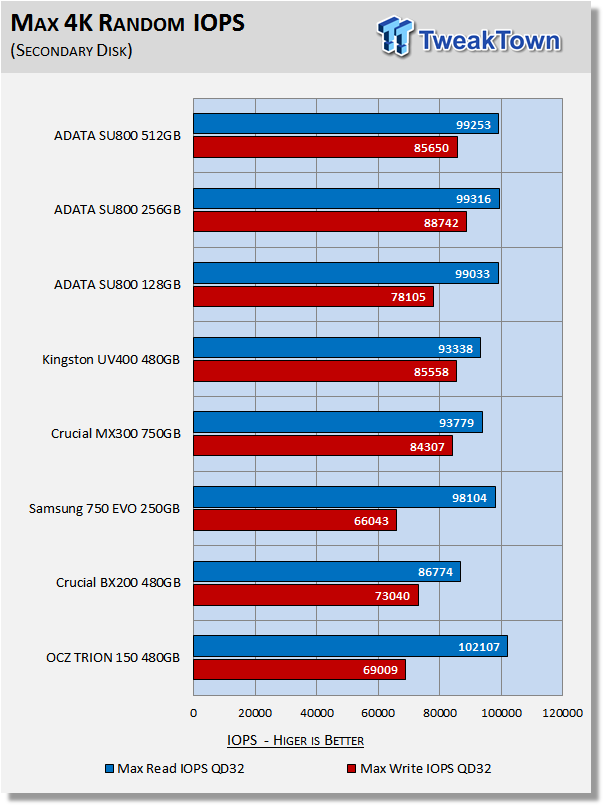
All three capacity points meet or exceed ADATA's factory specs. The SU800 is able to sustain high write IOPS for the entire 30 seconds of our test, which is something the planar-based SSDs in our test pool cannot do for more than a few seconds.
Iometer – Disk Response
Version and / or Patch Used: Iometer 2014
We use Iometer to measure disk response times. Disk response times are measured at an industry accepted standard of 4K QD1 for both write and read. Each test runs twice for 30 seconds consecutively, with a 5-second ramp-up before each test. We partition the drive/array as a secondary device for this testing.
Avg. Write Response

Avg. Read Response

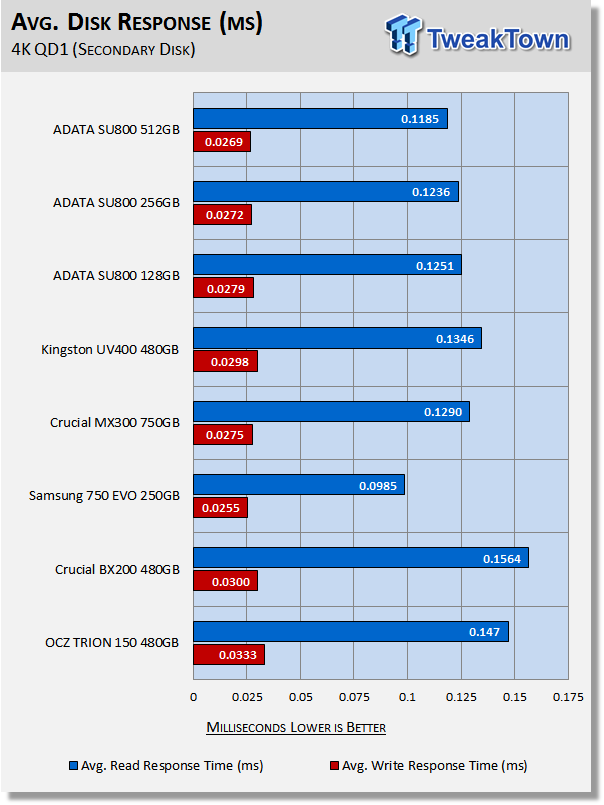
The SU800's deliver better read response than Crucial's MX300 at all three capacity points. The 512GB model delivers better read response than the smaller capacity points. Although, its read response is still a distant second place to that of the 750 EVO.
DiskBench - Directory Copy
Version and / or Patch Used: 2.6.2.0
We use DiskBench to time a 28.6GB block (9,882 files in 1,247 folders) composed primarily of incompressible sequential and random data as it's transferred from our DC P3700 PCIe NVME SSD to our test drive. We then read from a 6GB zip file that's part of our 28.6GB data block to determine the test drive's read transfer rate. Our system is restarted prior to the read test to clear any cached data, ensuring an accurate test result.
Write Transfer Rate

Read Transfer Rate

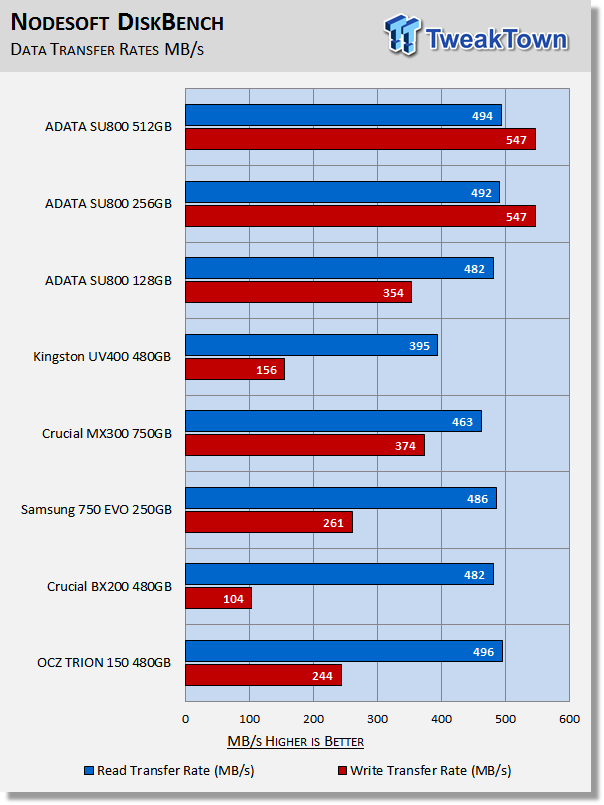
When testing write transfer rates, we have a rule of thumb. If any SSD cannot achieve 200 MB/s with our write transfer test, that SSD will not receive a TweakTown recommendation. Looking at the write transfer performance of Crucial's SM2256-powered BX200 shows us two things. First, we can see that SM2256 powered SSDs cannot meet our minimum requirement for receiving a TweakTown recommendation. Second, look at the massive write transfer performance coming the 256GB and 512GB SM2258-controlled SU800's.
SMI's new SLC caching scheme is so effective that it is able to write large blocks of data even faster than it can be read. This is a big time win for Silicon Motion.
Benchmarks (Secondary) – PCMark 8 Extended
Futuremark PCMark 8 Extended
Heavy Workload Model
PCMark 8's consistency test simulates an extended duration heavy workload environment. PCMark 8 has built-in, command line executed storage testing. The PCMark 8 Consistency test measures the performance consistency and the degradation tendency of a storage system.
The Storage test workloads are repeated. Between each repetition, the storage system is bombarded with a usage that causes degraded drive performance. In the first part of the test, the cycle continues until a steady degraded level of performance has been reached. (Steady State)
In the second part, the recovery of the system is tested by allowing the system to idle and measuring the performance after 5-minute long intervals. (Internal drive maintenance: Garbage Collection (GC)) The test reports the performance level at the start, the degraded steady-state, and the recovered state, as well as the number of iterations required to reach the degraded state and the recovered state.
We feel Futuremark's Consistency Test is the best test ever devised to show the true performance of solid state storage in an extended duration heavy workload environment. This test takes on average 13 to 17 hours to complete and writes somewhere between 450GB and 14,000GB of test data depending on the drive. If you want to know what an SSDs steady state performance is going to look like during a heavy workload, this test will show you.
Here's a breakdown of Futuremark's Consistency Test:
Precondition phase:
1. Write to the drive sequentially through up to the reported capacity with random data.
2. Write the drive through a second time (to take care of overprovisioning).
Degradation phase:
1. Run writes of random size between 8*512 and 2048*512 bytes on random offsets for 10 minutes.
2. Run performance test (one pass only).
3. Repeat 1 and 2 for 8 times, and on each pass increase the duration of random writes by 5 minutes.
Steady state phase:
1. Run writes of random size between 8*512 and 2048*512 bytes on random offsets for 50 minutes.
2. Run performance test (one pass only).
3. Repeat 1 and 2 for 5 times.
Recovery phase:
1. Idle for 5 minutes.
2. Run performance test (one pass only).
3. Repeat 1 and 2 for 5 times.
Storage Bandwidth
PCMark 8's Consistency test provides a ton of data output that we use to judge a drive's performance.

We consider steady state bandwidth (the blue bar) our test that carries the most weight in ranking a drive/arrays heavy workload performance. Performance after Garbage Collection (GC) (the orange and red bars) is what we consider the second most important consideration when ranking a drive's performance. Trace-based steady state testing is where true high performing SSDs are separated from the rest of the pack.
When evaluating TLC-based SSDs, we like to focus on recovery performance more than steady-state. Our reasoning is that consumers who purchase low-cost TLC SSDs aren't likely going to be running workloads intense enough to induce a steady-state. We give the overall win to the 512GB SU800 because it maintains excellent steady state performance and recovers well. This testing clearly shows a profound performance increase as capacity goes up.
Bandwidth at Test Phase
We chart our test subject's storage bandwidth as reported at each of the test's 18 trace iterations. This gives us a good visual perspective of how our test subjects perform as testing progresses. This chart sheds more light on how the drives perform as they progress through the testing phases.
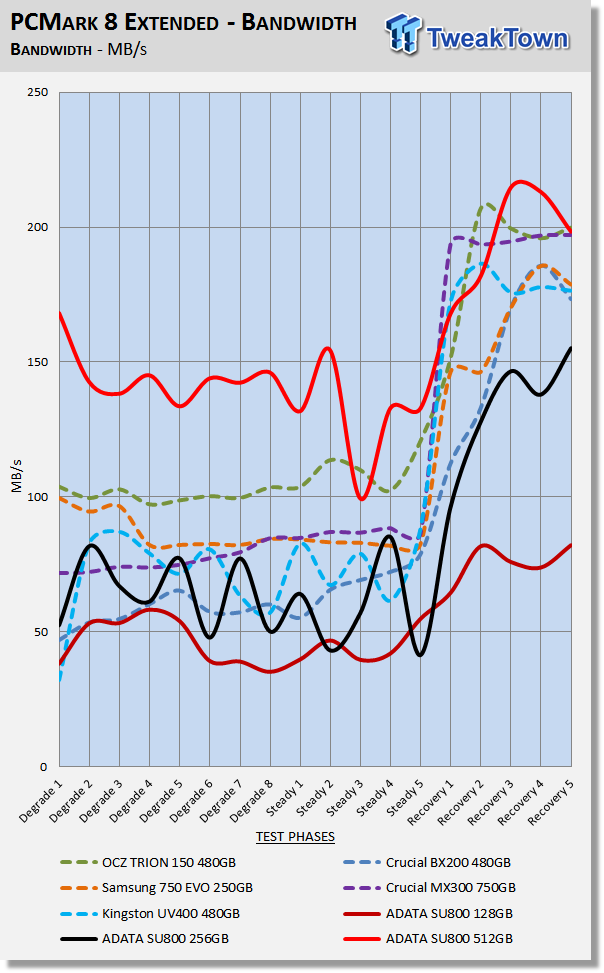
The 512GB SU800 is the best-performing SSD in our test pool. Most notably, the 512GB SU800 easily outperforms Crucial's 750GB MX300.
Total Access Time (Latency)
We chart the total time the disk is accessed as reported at each of the test's 18 trace iterations.
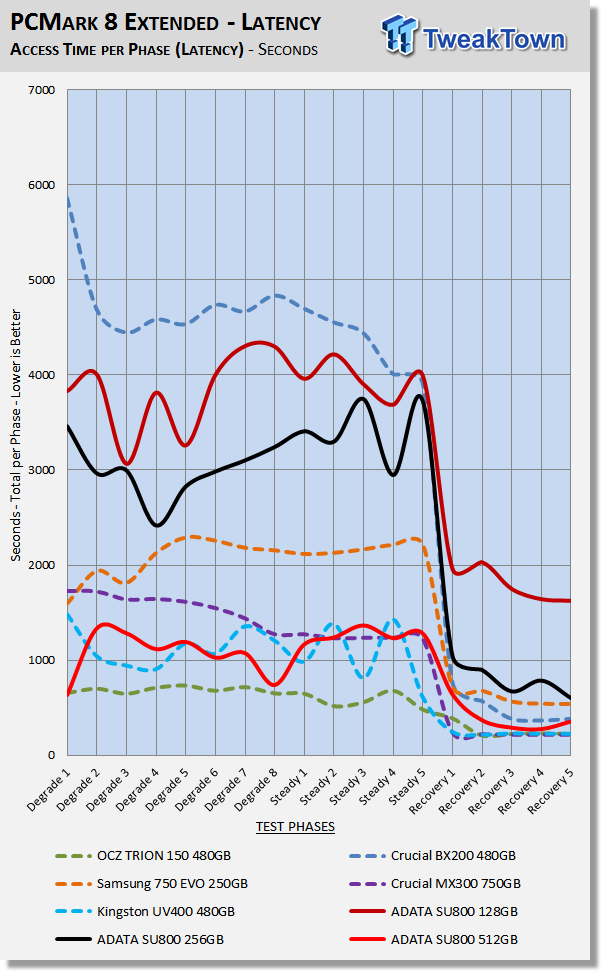
Low latency translates to the real-world as snappiness.
Disk Busy Time
Disk Busy Time is how long the disk is busy working. We chart the total time the disk is working as reported at each of the tests 18 trace iterations.

When latency is low, disk busy time is low as well.
Data Written
We measure the total amount of random data that our test drive/array is capable of writing during the degradation phases of the consistency test. Pre-conditioning data is not included in the total. The total combined time that degradation data is written to the drive/array is 470 minutes. This can be very telling. The better a drive/array can process a continuous stream of random data; the more data will be written.
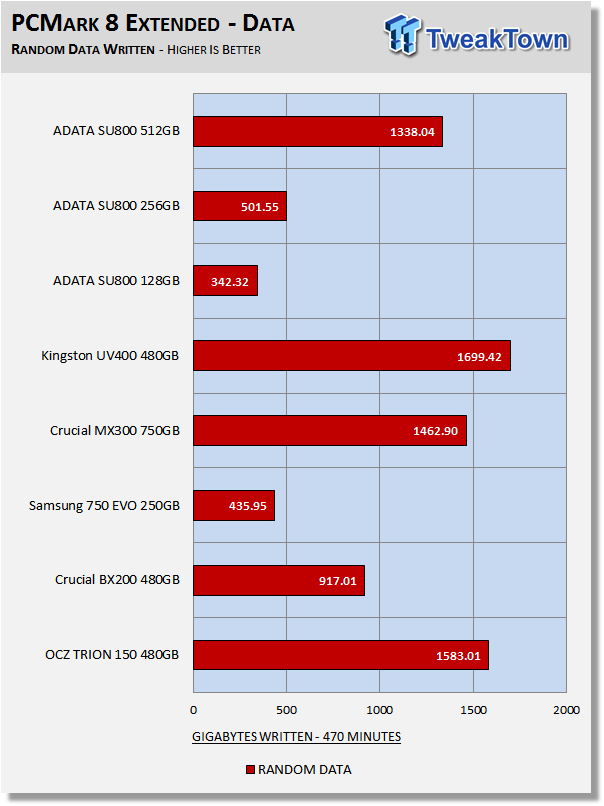
Overprovisioning and write latency are the biggest factors that determine the outcome of this portion of the test. The 512GB model again shows itself to be much more powerful than the smaller capacity models.
Benchmarks (Secondary) - 70/30 Mixed Workload
70/30 Mixed Workload Test (Sledgehammer)
Version and / or Patch Used: Iometer 2014
Heavy Workload Model
This test hammers a drive so hard we've dubbed it "Sledgehammer." Our 70/30 Mixed Workload test is designed to simulate a heavy-duty enthusiast/workstation steady-state environment. We feel that a mix of 70% read/30% write, full random 4K transfers best represents this type of user environment. Our test allows us to see the drive enter into and reach a steady state as the test progresses.
Phase one of the test preconditions the drive for 1 hour with 128K sequential writes. Phase two of the test runs a 70% read/30% write, full random 4K transfer workload on the drive for 1 hour. We log and chart (phase two) IOPS data at 5-second intervals for 1 hour (720 data points). 60 data points = 5 minutes.

What we like about this test is that it reflects reality. Everything lines up, as it should. Consumer drives don't outperform Enterprise-Class SSDs that were designed for enterprise workloads. Consumer drives based on old technology are not outperforming modern Performance-Class SSDs, etc.
This chart is basically unreadable because of the massive variability that most of the drives display. We need to look at the average performance to see what is actually happening. Here again, the 512GB SU800 handles heavy workloads better than the rest of the SSDs that comprise our test pool.
Maxed-Out Performance (MOP)
This testing is just to see what the drive is capable of in an FOB (Fresh Out of Box) state under optimal conditions. We are utilizing empty volumes of Windows 10 and Windows Server 2008 R2 64-bit for this testing.
Windows 10 MOP
ADATA SU800 512GB
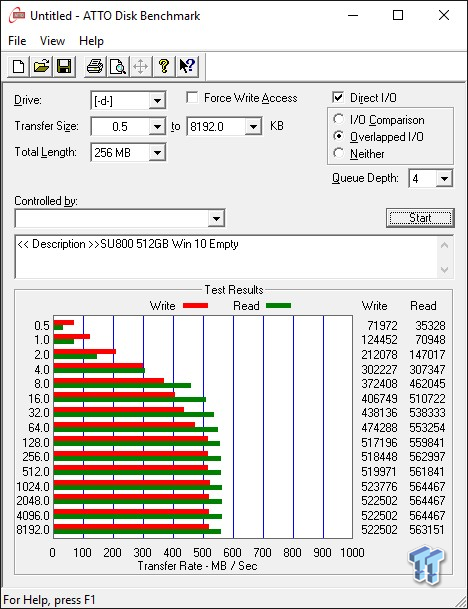
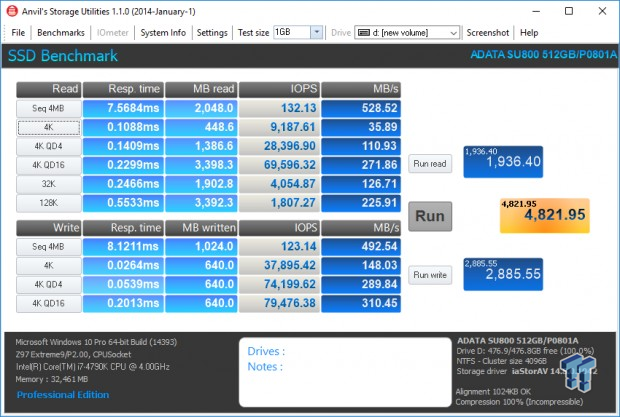
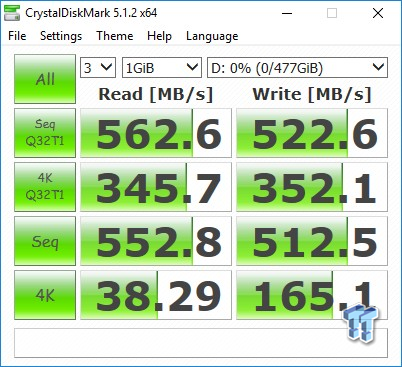
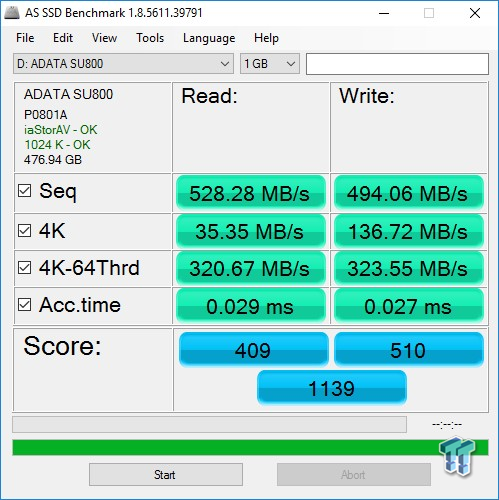


Windows Server 2008 R2 MOP
ADATA SU800 512GB
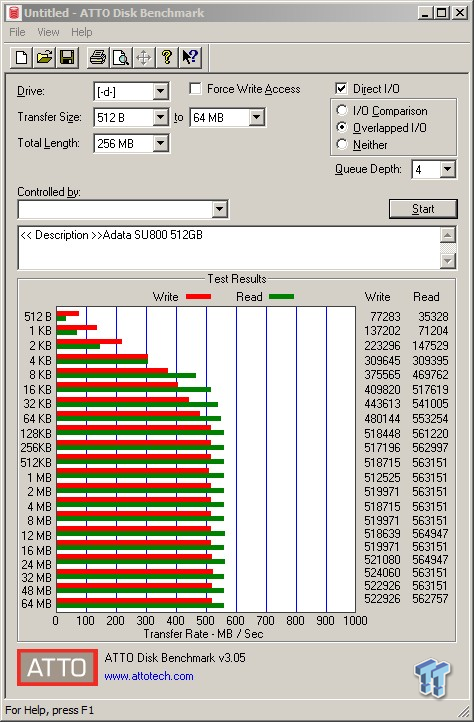
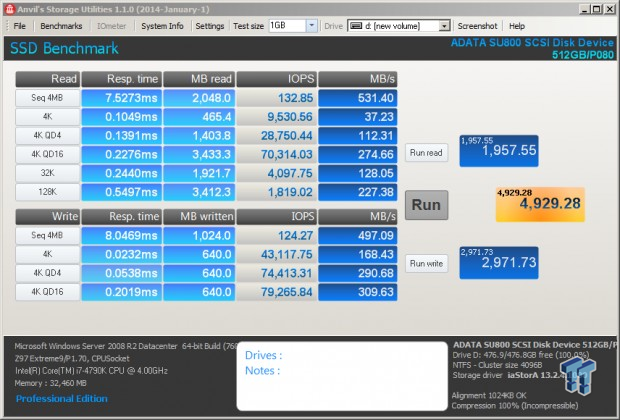
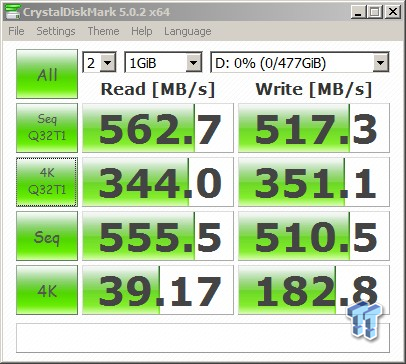
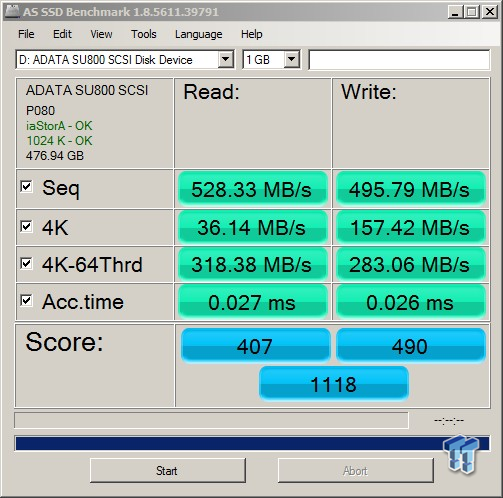



Final Thoughts
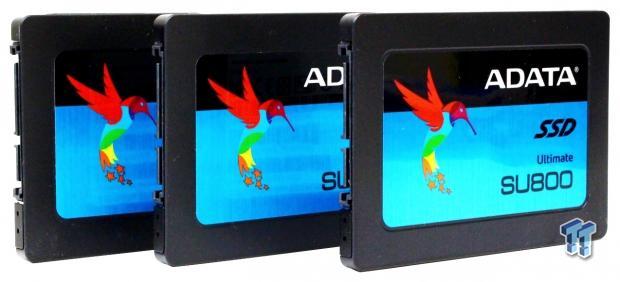
ADATA's Ultimate SU800 will be competing primarily with Crucial's MX300 for market share. Both SSDs are low-cost mainstream performers that deliver an excellent user experience. Both employ essentially the same flash array and both deliver performance that is comparable to one another. The main differentiator between the two competitors comes down to the flash processor. This is where we feel the SU800 may have a slight edge. Crucial's MX300 and ADATA's Ultimate SU800 are both backed by a three-year limited warranty. The warranty limitation comes down to endurance or TBW (Total Bytes Written).
This is where we see the advantage going to ADATA because of the SM2258 controller at its heart. The SMI SM2258 controller that powers the SU800 features advanced LDPC (Low Density Parity Check) error correction. LDPC error correcting is ideal for TLC-based SSDs because it significantly increases the endurance of the drive's flash array. LDPC is the reason why ADATA's Ultimate SU800 has more than double the rated endurance of Crucial's MX300. It has been our experience that an SSD's endurance rating (TBW) is a better indicator of how long a drive will actually last than the length of its warranty.
Micron 3D flash is more about density than anything else, which is why we are kind of puzzled to see companies offering capacities less than 512GB. Based on cost per gigabyte and our testing results, we believe the 512GB model will provide the best value. The 512GB model is significantly more powerful than the smaller capacity points. It is also less expensive per gigabyte of storage and more future proof because you get more capacity which inevitably most users will need as time goes on.
ADATA's Ultimate SU800 series SSDs deliver an excellent SSD user experience at a very low price point, which is why it is TweakTown recommended.
Pros:
- Price Point
- Moderate Workload Performance
- Build Quality
- Free Software
Cons:
- Low Performance at 128GB Capacity

| Performance | 85% |
| Quality including Design and Build | 90% |
| General Features | 90% |
| Bundle and Packaging | 90% |
| Value for Money | 90% |
| Overall | 89% |
The Bottom Line: Low cost, high endurance, and good performance make the ADATA Ultimate SU800 an excellent mainstream SSD.
PRICING: You can find products similar to this one for sale below.
 United
States: Find other tech and computer products like this
over at Amazon.com
United
States: Find other tech and computer products like this
over at Amazon.com
 United
Kingdom: Find other tech and computer products like this
over at Amazon.co.uk
United
Kingdom: Find other tech and computer products like this
over at Amazon.co.uk
 Australia:
Find other tech and computer products like this over at Amazon.com.au
Australia:
Find other tech and computer products like this over at Amazon.com.au
 Canada:
Find other tech and computer products like this over at Amazon.ca
Canada:
Find other tech and computer products like this over at Amazon.ca
 Deutschland:
Finde andere Technik- und Computerprodukte wie dieses auf Amazon.de
Deutschland:
Finde andere Technik- und Computerprodukte wie dieses auf Amazon.de
What's in Jon's PC?
- CPU: AMD Ryzen 7800X 3D
- MOTHERBOARD: GIGABYTE AORUS Master X670E
- RAM: Kingston Fury Renegade 7200MHz 32GB
- GPU: ZOTAC AMP Extreme GeForce RTX 4090
- SSD: Crucial T700 2TB Gen5
- OS: Windows 11 Pro
- COOLER: Lian Li Galahad 360 AIO
- CASE: Lian Li Lancool III
- KEYBOARD: Corsair K65 RGB Mini
- MOUSE: SteelSeries AEROX 5 Wireless
- MONITOR: ASUS ROG Strix PG27AQN 360Hz 1440p ULMB2
Similar Content
Related Tags

